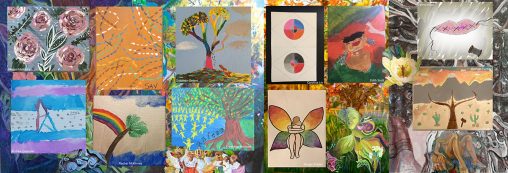 Wright State University modern languages students have put their feelings to the canvas following virtual seminars with international artists and scholars on topics ranging from music and poetry to African migration and the Panama Canal.
Wright State University modern languages students have put their feelings to the canvas following virtual seminars with international artists and scholars on topics ranging from music and poetry to African migration and the Panama Canal.
It was part of a novel language and art digital technology project overseen by Damaris Serrano, associate professor of Spanish. In 2018, Serrano received her native Panama’s highest literary honor for her essay “Panama Post/Modernity/Post: (The journey of a Poetic-Narrative Strategy).”
Serrano arranged to have well-known artists, authors and scholars from Panama, Mexico and the United States conduct virtual workshops with her students. The students then analyzed poems and texts and each produced a painting about their feelings of the experience.
“I am not an artist by any means, but being able to express through that avenue was challenging and relaxing and liberating in one exercise,” said Rachael Mckinney, a Spanish and international studies major from Cedarville.
Mckinney painted a palm tree bending in the wind of a storm with a rainbow overhead in the background.
“I chose that painting because I believe that we always have storms in life that we pass through. However, a palm tree bends in the wind, moves with the storm, but rarely breaks,” she said. “One can make it through a storm without breaking and become stronger. The rainbow signifies hope.”
The students’ artwork will be used in a digital collage on the cover of a journal that will be posted on the Department of Modern Languages website in the spring.
“This really has been a collaboration in the classroom at a time when we are separated,” said Serrano. “But knowledge and culture is always a way to connect us all. It is a reinforcement of our identity.”
The course is based on modern and postmodern identity.
“The students had to explore their inner thoughts about it,” said Serrano. “They created an identity doll in order to know how far they could trace their ancestors. When they explained that in class, it was touching. I got goosebumps.”
Mckinney said the exercise helped the students gain a greater understanding of who they are.
“It also helps appreciate how far we’ve come,” she said. “What our ancestors faced gives a deeper appreciation for where we are today.”
Instrumental to bringing the project to fruition was Beth Anderson, night supervisor of information commons at Wright State University Libraries. Anderson works at the Student Technology Assistance Center (STAC), assisting students with multimedia projects.
Another crucial person was Ben Penry, digital technology analyst for the Center for Teaching and Learning. Penry digitally shadowed the classes to make sure that the guest speakers had the best digital connections and that everything went smoothly.
The artists and scholars who conducted the virtual workshops were:
- Nilsa Justavino de López, of Panama, taught a seminar about Afro descendants and the migration from Africa to the areas that speak Spanish in the continent. It was titled “Searching for the roots: Identity, Afro-descent and Art” and touched on language, music, folklore, food and traditions.
- Bladimir Víquez, of Panama, presented “The Panama Canal: An Encounter in the Heart of the World.” Víquez, whose areas of research include memory, identity and territory, is the recipient of numerous international grants.
- Daniel Nappo, of the United States, discussed “The Mexican Revolution and its Impact in the 20th Century and Beyond.” Nappo is a Fullbright recipient and an expert on Mexico, music and poetry.
- Gustavo Rodríguez Morán, of Mexico, presented “Chocolate, Mole and Tequila: Food in the telenovelas.” Morán is an expert on food, popular culture, comics and gender representation.
Anderson prepared the digital collage with Justavino’s paintings, then the students had to decide where in the digital canvas they felt their own painting would best fit.
“Seeing how the students interpret the assignment and the creativity shown by everyone has been wonderful,” said Anderson.
Mckinney said the project taught her that every culture has a lesson to offer, every heritage has a story, and stories and lessons can be told through poetry, paintings, historical documents and passed down from generation to generation.
“What I am experiencing today will matter down the road to the next generation and should be captured in some form because it enhances the culture and the globalism that we all experience in a variety of ways,” she said.

 Wright State revives student-faculty collaborative writing journal
Wright State revives student-faculty collaborative writing journal  Fulfilling dreams
Fulfilling dreams  Wright State alumna Nicole Scherzinger wins top British theatre award as star of ‘Sunset Boulevard’
Wright State alumna Nicole Scherzinger wins top British theatre award as star of ‘Sunset Boulevard’  Healthy competition
Healthy competition  Wright State’s annual Spring Dance Concert showcases region’s vibrant dance community
Wright State’s annual Spring Dance Concert showcases region’s vibrant dance community 